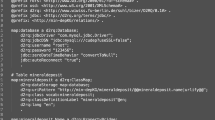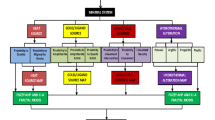Abstract
Multiple geoscience databases as big data can be interpreted and understood by geologists using mineral system, including geological setting, metallogenic progress, and ore-bearing geological objects (e.g., porphyry, skarn, fault, fold, and stratum), and they can be used to extract exploration criteria based on GIS technology, weights of evidence (WofE), and concentration-area (C-A) methods for potential targets. In this paper, Luanchuan polymetallic district as a case study, the methodology and mineral system analysis based on the multiple datasets (geology, geophysics, geochemistry, remote sensing, and exploration engineering) were summarized as follows: (1) the databases’ construction using multiple geosciences involving the 1:25,000 scale gravity and magnetic dataset, 1:10,000 scale geologic map, and tens 1:5000 geological, geochemical, and geophysical cross-sections, more than 400 borehole datasets with 8000 assay; (2) Pb-Zn polymetallic deposit datasets involving magma-hydrothermal metallogenic model, ore-forming and rock-forming chronology, geochemistry and geophysics of stratum, and intrusion rocks; (3) GIS spatial analysis technology, 3D visualization technology, WofE, and C-A fractal methods were used to derive exploration criteria at different levels (the near surface (0 m), − 400 m, − 800 m); (4) potential target identification in vertical direction are compared and interactive interpreted to decease the uncertainty of the potential targets in the study area. The results show that the multiple geoscience datasets can be used to extract exploration criteria from surface to depth, the exploration criteria can be validated in the 3D geological model additional metallogenic model/genesis understanding (knowledge) and known polymetallic deposits of mineral system. The methodology can be used in the other mineral exploration districts or camps in the world.
























Similar content being viewed by others
References
Agterberg FP, Cheng Q (2002) Conditional independence test for weights-of-evidence modeling. Nat Resour Res 11:249–255
Bansal AR, Gabriel G, Dimri VP, Krawczyk CM (2011) Estimation of the depth to the bottom of magnetic sources by a modified centroid method for fractal distribution of sources: an application to aeromagnetic data in Germany. Geophysics 76:11–22
Bonham-Carter GF (1994) Geographic information systems for geoscientists: modelling with GIS. Elsevier, Amsterdam, p 398
Campos LD, de Souza SM, de Sordi DA, Tavares FM, Klein EL, dos Santos Lopes EC (2017) Predictive mapping of prospectivity in the Gurupi orogenic gold belt, north–northeast Brazil: an example of district-scale mineral system approach to exploration targeting. Nat Resour Res 26(4):509–534
Cao HW, Zhang ST, Zheng L, Liu RP, Tian HH, Zhang XH, Li JJ (2014) Trace element geochemical characteristics of sphalerite in the Zhongyuku (Pb)–Zn deposit of the Luanchuan, southwest of China. J Mineral Petrol 34:50–59 in Chinese with English abstract
Cao HW, Zhang ST, Santosh M, Zheng L, Li T b, Li D, Zhang XH, Zhang YH (2015) The Luanchuan Mo–W–Pb–Zn–Ag magmatic–hydrothermal system in the East Qinling metallogenic belt, China: constrains on metallogenesis from C–H–O–S–Pb isotope compositions and Rb–Sr isochron ages. J Asian Earth Sci 111:751–780
Calcagno P, Chilés J, Courrioux G, Guillen A (2008) Geological modeling from field data and geological knowledge: part I. Modelling method coupling 3D potential-field interpolation and geological rules. Phys Earth Planet Inter 171(1–4):147–157
Carranza EJM (2009) Controls on mineral deposit occurrence inferred from analysis of their spatial pattern and spatial association with geological features. Ore Geol Rev 35:383–400
Carranza EJM (2011) From predictive mapping of mineral prospectivity to quantitative estimation of number of undiscovered prospects. Resour Geol 61:30–51
Carranza EJM (2017) Natural resources research publications on geochemical anomaly and mineral potential mapping, and introduction to the special issue of papers in these fields. Nat Resour Res 26(4):379–410
Carranza EJM, Sadeghi M (2010) Predictive mapping of prospectivity and quantitative estimation of undiscovered VMS deposits in Skellefte district (Sweden). Ore Geol Rev 38:219–241
Chen YJ (2006) Orogenic-type deposits and their metallogenic model and exploration potential. Geol China 33:1181–1192
Cheng Q (1995) The perimeter–area fractal model and its application to geology. Math Geol 27:69–82
Cheng Q (2004) A new model for quantifying anisotropic scale invariance and for decomposition of mixing patterns. Math Geol 36:345–360
Cheng Q (2008) Non-linear theory and power-law models for information integration and mineral resources quantitative assessments. Math Geosci 40:503–532
Cheng Q (2012) Boost weight of evidence (Boost WofE) new method in quantitative assessment of mineral resources application. J Jilin Univ (Earth Sci Ed) 42(6):1976–1984
Cheng Q, Agterberg FP, Ballantyne SB (1994) The separation of geochemical anomalies from background by fractal methods. J Geochem Explor 54:109–130
Cox D, Singer DA (1986) Mineral deposit models. U.S. Geological Survey Bulletin 1693, vol 379. United States Government Printing Office, Washington
Duan SG, Xue CJ, Chi GX, Liu GY (2011) Ore geology, fluid inclusion, and sand Pb-isotopic constraints on the genesis of the Chitudian Zn–Pb deposit, southern margin of the North China craton. Resour Geol 61:224–240
Harris JR, Grunsky E, Behnia P, Corrigan D (2015) Data- and knowledge-driven mineral prospectivity maps for Canada’s North. Ore Geology Review
Henan Institute of Geological Survey, 2014. Deep prospecting demonstration research: a case study of Luanchuan Mo polymetallic district (Report: Ministry of Land and Resources Public Service Sectors Fund (Grant No. 201111007). pp. 1–325 (in Chinese)
Houlding SW (1994) 3D geoscience modeling-computer techniques for geological characterization. Springer-Verlag, Berlin, pp 1–6
Huston DL, Mernagh TP, Hagemann SG, Doublier MP, Fiorentini M, Champion DC (2016) Mineral system analysis: quo vadis S.G. Ore Geol Rev 76:504–522
Joly A, Porwal A, McCuaig TC (2012) Exploration targeting for orogenic gold deposits in the Granites-Tanami Orogen: mineral system analysis, targeting model and prospectivity analysis. Ore Geol Rev:349–383
Knox-Robinson CM, Wyborn LAI (1997) Towards a holistic exploration strategy: using geographic information systems as a tool to enhance exploration. Aust J Earth Sci 44:453–463
Li D, Zhang S, Yan C, Wang G, Song Y, Ma Z, Han J (2012) Late Mesozoic time constraints on tectonic changes of the Luanchuan Mo belt, East Qinling orogen, Central China. J Geodyn 61:94–104
Li S, Meng X, Fan Z, Yao C, Yu C, Guo L, Wan J, Zhang H (2007) Application of fine gravity and magnetic data processing and interpretation in the prospecting of crisis mines. Earth Sci J China Univ Geosci 32(4):559–564
Mallet JL (2002) Geomodeling. Applied Geostatistics. Oxford University Press, New York, pp 1–10
Mandelbrot B (1983) The fractal geometry of nature, updated and augmented edition. W.H. Freeman and Company, New York, p 468
Mao JW, Ye HS, Wang RT, Dai JZ, Jian W, Xiang JF, Zhou K, Meng F (2009) Mineral depositmodel of Mesozoic porphyry Mo and vein type Pb–Zn–Ag ore deposits in the East Qinling, Central China and its implication for prospecting. Geol Bull China 29:72–79 in Chinese with English abstract
Meng X, Guo L, Chen Z, Li S, Shi L (2009) A method for gravity anomaly separation based on preferential continuation and its application. Appl Geophys 6(3):217–225
Mutele L, Billay A, Hunt JP (2017) Knowledge-driven prospectivity mapping for granite-related polymetallic Sn–F–(REE) mineralization, Bushveld Igneous Complex, South Africa. Nat Resour Res 26(4):535–552
Nykänen V, Niiranen T, Molnár F, Lahti I, Korhonen K, Cook N, Skyttä P (2017) Optimizing a knowledge-driven prospectivity model for gold deposits within Peräpohja Belt, northern Finland. Nat Resour Res 26(4):571–584
Tang L, Zhang ST, Wen CH, Tian HH, Zhang XH, Zhang YF, Chen HJ, Zhang W (2014) Ore-forming fluid geochemistry of the Sandaogou Pb–Zn–Ag deposit in Luanchuan region, Henan Province. Geoscience 28:359–368 (in Chinese with English abstract)
Tessema A (2017) Mineral systems analysis and artificial neural network modeling of chromite prospectivity in the Western Limb of the Bushveld Complex, South Africa. Nat Resour Res 26(4):465–488
Wang G, Carranza EJM, Zuo R, Hao Y, Du Y, Pang Z, Sun Y, Qu J (2012) Mapping of districtscale potential targets using fractal models. J Geochem Explor 122:34–46
Wang CM, He XU, Yan CH, Lü WD, Sun WZ (2013a) Ore geology, and H, O, S, Pb, Ar isotopic constraints on the genesis of the Lengshuibeigou Pb–Zn–Ag deposit, China. Geosci J 17:197–210
Wang G, Pang Z, Boisvert J, Hao Y, Cao Y, Qu J (2013b) Quantitative assessment of mineral resources by combining geostatistics and fractal methods in the Tongshan porphyry Cu deposit (China). J Geochem Explor 134:85–98
Wang G, Li R, Carranza EJM, Zhang S, Yan C, Zhu Y (2015) 3D geological modeling for prediction of subsurface Mo targets in the Luanchuan district, China. Ore Geol Rev 71:592–610
Yan C, Liu G (2004) Metallogenic characteristics and ore-prospecting suggestions of lead–zinc polymetallic deposits in southwestern Henan Province of China. Geol Bull China 23:1143–1148 in Chinese
Yan CH (2004) Study on inner structure of lead–zinc–silver mineralization system in eastern Qinling. Geological Press, Beijing, pp 1–144 in Chinese with English abstract
Yang F., et al. 2016. Timing of formation of the Hongdonggou Pb-Zn polymetallic ore deposit, Henan Province, China: evidence from Rb-Sr isotopic dating of sphalerites, Geosci Front, https://doi.org/10.1016/j.gsf.2016.06.001
Yang S (2014) 3D fault modeling of Luanchuan district. (Master’s thesis). China University of Geosciences, Beijing, p 87
Ye H, Mao J, Li Y (2006) Characteristics and metallogenic mechanism of Mo–W and Pb–Zn–Ag deposit in Nannihu ore field, Western Henan Province. Geoscience 20:165–174 (in Chinese)
Yang YF, Li N, Chen YJ (2012) Fluid inclusion study of the Nannihu giant porphyry Mo–W deposit, Henan Province, China: implications for the nature of porphyry ore-fluid systems formed in a continental collision setting. Ore Geol Rev 46:83–94
Yang Y, Chen YJ, Zhang J, Zhang C (2013) Ore geology, fluid inclusions and four stage hydrothermal mineralization of the Shangfanggou giant Mo–Fe deposit in eastern Qinling, central China. Ore Geol Rev 55:146–161
Zhao PD (1983) Statistical prediction of mineral deposit. Geology Press, Beijing, p 272
Zhao PD (2015) Digital mineral exploration and quantitative assessment in the big data age. Geological Bulletin of China 34(7):1255–1259
Zuo R (2012) Exploring the effects of cell size in geochemical mapping. J Geochem Explor 112:357–367
Zuo R, Agterberg FP, Cheng Q, Yao L (2009a) Fractal characterization of the spatial distribution of geological point processes. J Appl Earth Obs Geoinf 11:394–402
Zuo R, Cheng Q, Xia Q (2009b) Assessment of the uncertainty in estimation of metal resources of skarn tin in southern China. Ore Geol Rev 35:415–422
Zuo R, Cheng Q, Xia Q, Agterberg FP (2009c) Application of fractal models to distinguishing between different mineral phases. Math Geosci 41:71–80
Zuo R, Wang J (2016) Fractal/multifractal modeling of geochemical data: a review. J Geochem Explor 164:33–41
Acknowledgments
This research was supported by the National Natural Science Foundation of China (Grant No. 41572318), the National key Research Project (Grant Nos. 2016YFC0600107, 2016YFC0600506), and the National Science and Technology Support Project of the 12th “Five-Year Plan” (Grant No. 2011BAB04B06), and China Geological Survey, China (Grant # 12120115036401; DD2016005241).
Funding
This research was supported by the National Natural Science Foundation of China (Grant No. 41572318), the National key Research Project (Grant Nos. 2016YFC0600107, 2016YFC0600506), and the National Science and Technology Support Project of the 12th “Five-Year Plan” (Grant No. 2011BAB04B06).
Author information
Authors and Affiliations
Corresponding author
Additional information
Editorial handling: L. Z. Cheng
Rights and permissions
About this article
Cite this article
Jia, W., Wang, G. Multiple level prospectivity mapping based on 3D GIS and multiple geoscience dataset analysis: a case study in Luanchuan Pb-Zn district, China. Arab J Geosci 12, 332 (2019). https://doi.org/10.1007/s12517-019-4495-9
Received:
Accepted:
Published:
DOI: https://doi.org/10.1007/s12517-019-4495-9




